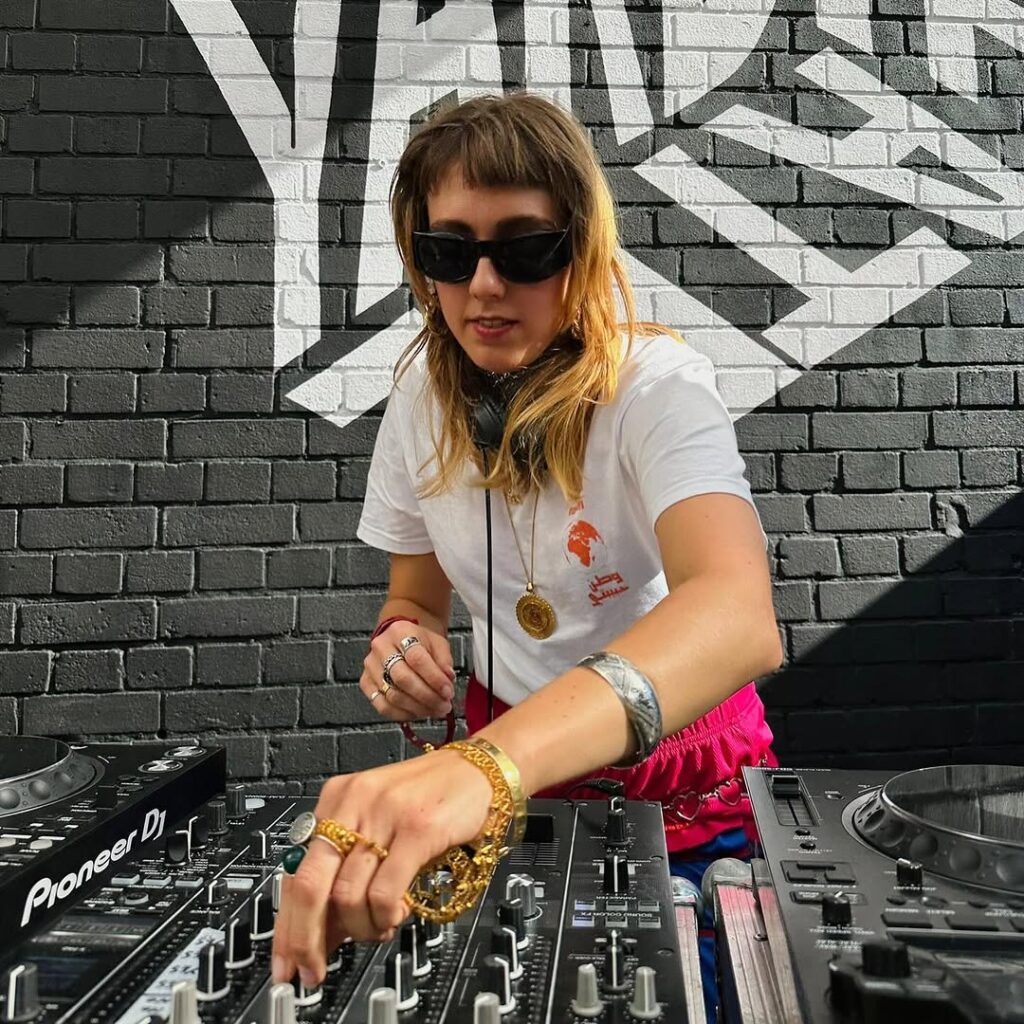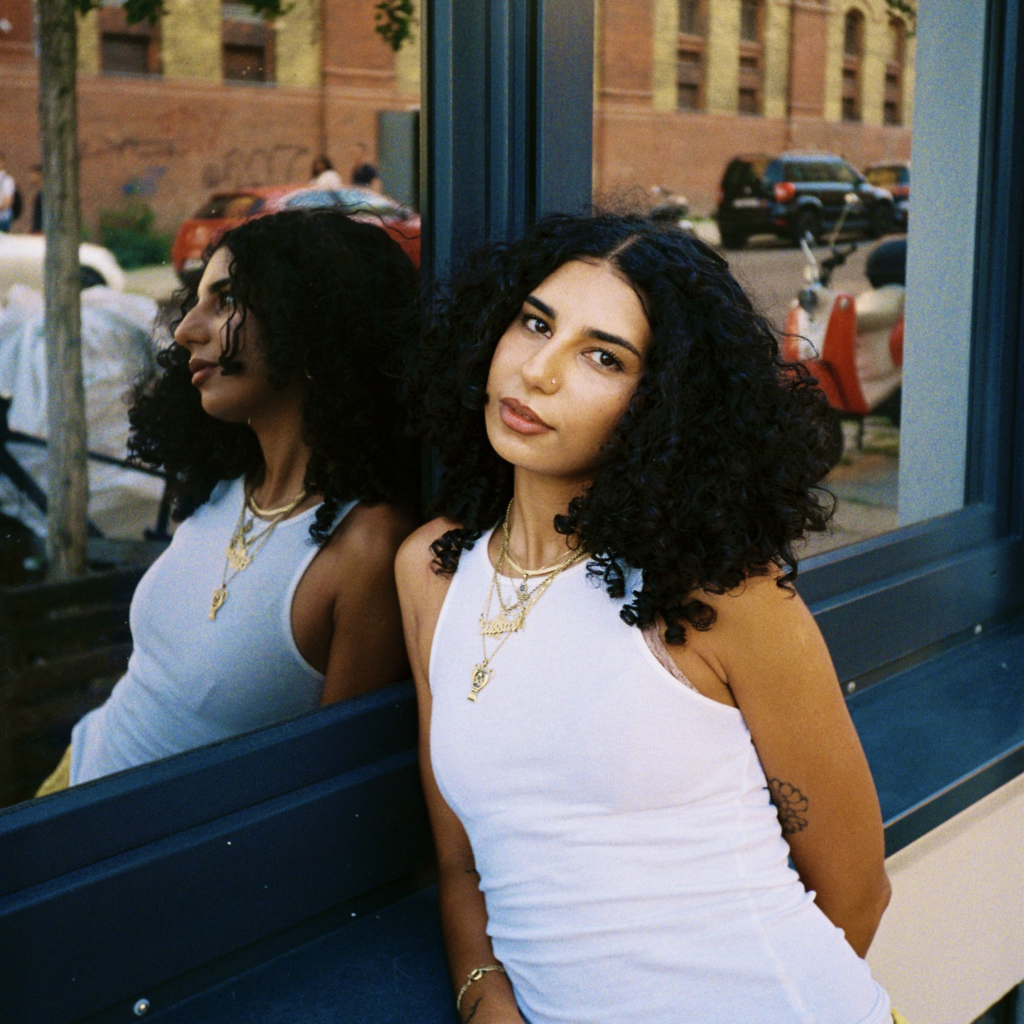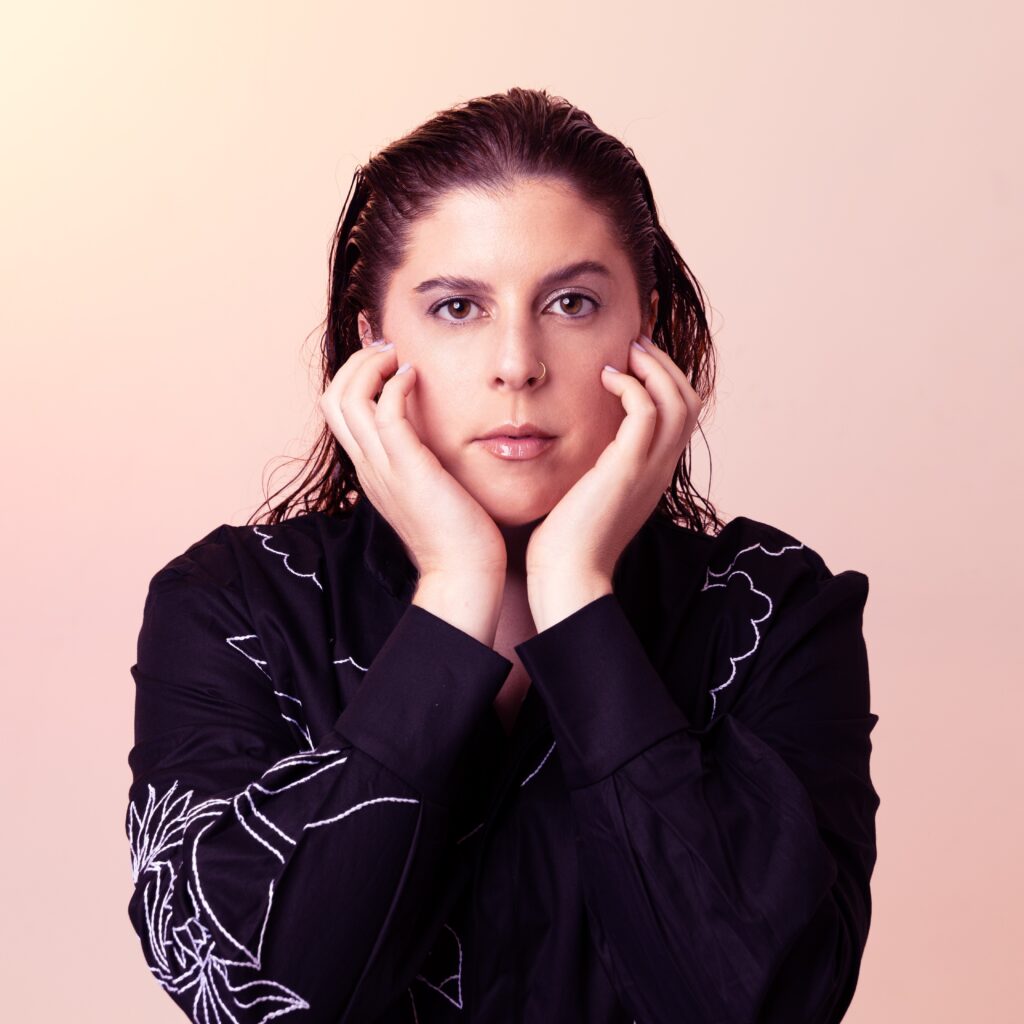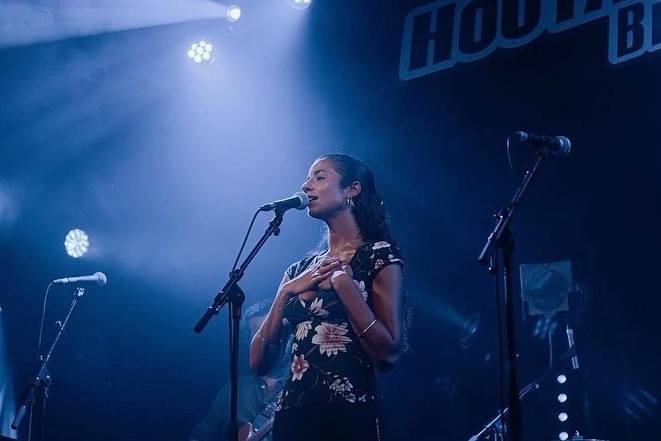Words by Mouna Madanat
Featured image: Layla Assam by Hayder Assam
This piece is a supplement within the “Frenquencies” issue
To be Arab, particularly Arab in the West, is political. Exploring how Arab culture is experienced in clubs in the West, specifically in London, has helped me examine the evolving dynamics between artists, venues, audiences, and the Arab diaspora.
This piece explores how Arab artists have navigated recent changes in the industry’s landscape through the lived experiences of four female Arab performers in the West, before and since the genocide in Gaza started. It’s informed by interviews with British, Iraqi-Palestinian singer Layla Assam’s, whose jazz-focused music and lyrics create an ethereal atmosphere that transports listeners; Iraqi-British DJ, radio host, nightlife curator and founder of SWANA club night Habibti Nation, Luma, who incorporates 2000s Arabic pop and pan Arab-electronic music to bridge geographies; Lebanese-Palestinian DJ and fashion designer, Elissar, who blends genres to reflect her many influences, from Arabic music to jungle and grime; and British-Lebanese producer and DJ Saliah whose work reimagines Arabic pop classics into global club sounds.
Here, I focus on female-identifying Arab artists because of the ways they are doubly-politicized, both for their Arab identity and their gender. They are often criticized and perceived not for what they create, but for who they are. This leads to deeper insights about the stakes of performing in this current landscape – its politics of such spaces, the ways artists are pigeonholed, and the need to express oneself and beliefs fully, despite the repercussions.
Setting the Stage
The Western music industry has been criticized greatly for its resistance to platforming non-Western voices. While this has shifted more recently, the genocide in Gaza has been a spark for change, particularly for Arab artists and creatives. While new stages have emerged and organized around the cause, there are also heightened challenges around funding, political alignments, and the implications of playing following October 7.

Luma by Kyran Reid
Since many artists’ identity, beliefs, and practice are all interconnected with their work and practice, it is impossible to separate their politics from careers, especially in this climate — this entails personal choice and smart decision-making. Arab artists are long accustomed to having their image controlled in the West – particularly if they are “too political” – and are aware of the repercussions this might have on whether they will be able to get work in the future. But as Layla put it, now, “I’m taking no bullshit from anyone, and allowing my music and every space I inhabit to be my choice.” With carefully vetting potential employers comes greater freedom and greater trust. Saliah explained, “It’s a wake-up call to how we should all be functioning in our life, according to boycotts and ethical work. I’m counting my losses as my wins.”
Creating art from a marginalized position has always been difficult, but it’s been even harder to do this whilst watching your homeland be mercilessly destroyed. And yet, being in the position to bring people together in a moment of joy while they’re grieving is somehow transformative. Saliah echoes this, saying, “It’s a strange role to be in, but I’ve found comfort in knowing that I create spaces that allow people to collectively mourn and feel rage.” It’s uniting people of the region, who may feel especially isolated and far from their homeland, as a way to heal. Perhaps, it’s one of the most important things we can do for one another/the community.
Facing Pigeon-holing and Tokenism
Too often, Arab artists are faced with being labelled “exotic” or “Oriental,” with Western eyes hungrily picking and choosing which parts are trendy while rejecting others. Pigeonholed and tokenized, and pushed in the category of “Arab artists” while forced to prove they are “Arab enough” but not “too Arab”, these artists are now simply choosing to play “for us.”
With support of Palestine becoming normalized, even trending, in some UK music spaces, new opportunities are emerging for Arab artists. This does not mean playing for the white gaze, or selling oneself as a “SWANA product,” as Saliah put it. Luma explained, “this trend isn’t necessarily bad, if it means continued engagement with the cause and the artists themselves.” It’s an opportunity for those from outside the region to engage, but they must recognize the politics. As Saliah says, “they’re always welcome, but are guests in that space.”

Elissar by Ali Badi
This new acceptance has also increased pressures to perform Arabness in ways that aren’t necessarily authentic to the artist. Such demands have harmful implications: they can perpetuate stereotypes and break down essential communities. Western identity politics plays a role in this, even creating the expectation that one must be the “perfect Arab victim” as Layla describes it, rather than an artist with “an amalgamation of identities” which she’s finally allowing herself to embrace. It’s difficult to not adhere to the noise from the outside – to do so is a revolution in itself. For others like Elissar, it’s a pressure she also puts on herself; it’s something you continuously have to embody if you’re Palestinian because “your existence on this earth has always been something big.”
The industry still has a long way to go in allowing Arab creatives to purely exist as artists, not only as a distilled version of themselves. Is following Arabs as a “trend” just another form of Orientalism or othering?
Shifting Politics
For many, the genocide has rekindled a reevaluation of the politics and identities that we share. There is wariness of being too open, a need to be informed, and developing effective strategies about when to speak out. In truth, while strengthened by community and belief, many Arab diaspora creatives still fear backlash, particularly if it affects their respective careers.
This is not the case for these four artists, who fearlessly disregard these risks. Music has historically been a site of resistance within marginalized communities, as a mode to express oneself. This is the case for Elissar as she isn’t able to be eloquent in the way she wants with words, admitting that music is her “venting method, it’s where I make my stance clear.” Luma reminded me that marginalized groups “have always escaped to underground spaces to express themselves and unite.” Even beyond underground music settings, performance is a tool to be political and to have one’s politics heard.
Arabs living outside often maintain strong ties to their respective homelands, and when it comes to Palestine, many continue to feel a duty to advocate for them and also Palestine. Layla told me that her politics are always present: “I’m Palestinian first, so my land comes first, and my artistry comes after.” This has meant facing repercussions for speaking out and confronting label executives who told her she wouldn’t make it if she mentioned her Arabness. Now, none of us can escape the grave politics of the present — whether in diaspora or back home — and it feels more right to stay true to one’s community, and beliefs than be concerned about losing opportunities. Saliah reiterates this, explaining that politics isn’t something she can ignore, saying “I’d rather lose out again and again, to be able to show up as my true self.”

Saliah by Gummy Studios, creative direction by Gabriella Khouri, clothing by Salim Azzam, styling by Joelle Abou El Nasr,
make up by Elias Chamchoum, hair by Marcos Merhy
There is an additional layer of politics on a structural level, with each venue receiving funding from different avenues, at times taking an “apolitical” stance to stay commercially viable. But politics are also shown in our actions, and this is where social, artistic, and political movements collide. Since October 7th, new movements including DJs against Apartheid, Ravers for Palestine, and more have emerged to give an avenue for collective action, push for systemic change, and publicly endorse one’s commitments. In line with boycott and divestment campaigns, these are a channel for personal responsibility and to encourage venues themselves to be more transparent and accountable in their funding, the products they use and the services they provide.
Conclusion
What these conversations have highlighted is how critical it is to consider the powers surrounding us at all levels, and the significance of every choice we make. We have a lot to learn, thus taking any industry at face-value is dangerous, and we need now – perhaps more than ever – to stay alert and expand our knowledge about how we engage in sound and visibility.
It seems Arab artists today are pushed to carry ever-growing responsibilities, whether they want to or not. Despite not needing to educate Western audiences on the daily injustice our people face, many have a desire to use their platform to inform others, show diversity, raise awareness, and advocate for the collective struggle. This expectation to take a public stance is now felt by many of us – that silence in the face of occupation, injustice, and genocide is complicity.
As Layla said, “It’s my duty to talk about what’s happening. Art has always been part of our struggle, and I want to contribute to it in a way that makes everyone that’s come before me proud. I will never stop talking about Palestine.” We cannot stay silent even after a ceasefire, until a lasting justice is reached.

